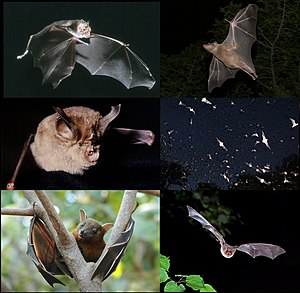Bat
| Bat Temporal range: Eocene – Present |
|
|---|---|
 |
|
| Clockwise: common Egyptian fruit bat Rousettus aegyptiacus, Mexican free-tail bat Tadarida brasiliensis, Myotis myotis, lesser short-nose fruit bat Cynopterus sphinx, horseshoe bat Rhinolophus ferrumequinum, common vampire bat Desmodus rotundus. | |
| Scientific classification | |
| Kingdom: | Animalia |
| Phylum: | Chordata |
| Clade: | Synapsida |
| Class: | Mammalia |
| Clade: | Scrotifera |
| Order: |
Chiroptera Blumenbach, 1779 |
| Suborders | |
 |
|
| Worldwide distribution of bat species | |
Bats are mammals of the order Chiroptera (/kaɪˈrɒptərə/; from the Ancient Greek: χείρ - cheir, "hand" and Ancient Greek: πτερόν - pteron, "wing") whose forelimbs form webbed wings, making them the only mammals naturally capable of true and sustained flight. By contrast, other mammals said to fly, such as flying squirrels, gliding possums, and colugos, can only glide for short distances. Bats do not flap their entire forelimbs, as birds do, but instead flap their spread-out digits, which are very long and covered with a thin membrane or patagium.
Bats are the second largest order of mammals (after the rodents), representing about 20% of all classified mammal species worldwide, with about 1,240 bat species divided into two suborders: the less specialized and largely fruit-eating megabats, or flying foxes, and the highly specialized and echolocating microbats. About 70% of bat species are insectivores. Most of the rest are frugivores, or fruit eaters. A few species, such as the fish-eating bat, feed from animals other than insects, with the vampire bats being hematophagous, or feeding on blood.
...
Wikipedia
